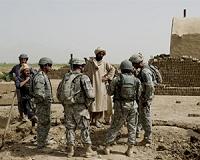| . |  |
. |
Kabul (AFP) Aug 23, 2010 With the withdrawal of the final American combat brigade from Iraq, US commanders in Afghanistan are hoping to emulate a strategy used there as they step up the war against insurgents. The number of US and NATO soldiers in Afghanistan is set to peak at 150,000 in coming weeks following orders from US President Barack Obama for an extra 30,000 troops, a "surge" aimed at speeding the end of the war. Critics say his goal to start drawing down the US presence from mid-2011 is unrealistic, as Afghanistan's security forces are not up to the task of taking charge of the war-torn country. The 2007 US troop surge in Iraq built on moves the year before to co-opt Sunni tribal militias and turn them against their former Al-Qaeda allies. Violence peaked, but the United States was soon able to capitalise on the two-pronged approach and turn around the war, which had raged increasingly out of control since the 2003 overthrow of Saddam Hussein. Now Washington is hoping the war in Afghanistan -- deadlier than ever and already two years older than the Iraq conflict -- can benefit from a similar strategy. The commander of international forces, US General David Petraeus, who took up his post on July 4, was quick to press for what are now called Local Police Forces -- armed men paid by the government to defend their villages. The programme is already under way in central Wardak and southern Uruzgan provinces, with plans to extend it to the toughest bastions of insurgency in the south, southwest and east, deputy interior minister Mohammad Munir Mangal has said. Unlike the Iraqi militias, which were drawn largely along tribal lines, Afghanistan's are localised at village level, officials said. "It will be up to 10,000 people, in perhaps something like 30 districts all over the country. They will have uniforms, small arms only, radios, but they cannot arrest," said the spokesman for NATO's International Security Assistance Force (ISAF) General Josef Blotz. "It's like a local neighbourhood watch for defence purposes only. They won't be used as fighting units. "We need temporary solutions. After two to three years, they can be dissolved or integrated into the police." Stephen Biddle, an expert on defence policy at Washington think-tank the Council on Foreign Relations, said the village forces plan for Afghanistan had less potential than the Iraqi militias, which were made up of former insurgents. "In Iraq, the SOI (Sons of Iraq) were mostly insurgents. When these insurgents became SOI, it dramatically reduced the threats," said Biddle, who advised Petraeus in Iraq. "The village defence force concept in Afghanistan has substantially less potential -- it can be useful as a modest contributor in a limited role, but I don't think it has the potential to transform the security situation. "The question is how broadly we are going to apply the programme," he said. Some observers have said it would be better to reinforce the police -- regarded largely as ineffective and corrupt -- and the under-funded military, rather than arm the tribes. Karzai initially opposed the village militia plan, telling US media when it was first mooted two years ago: "If we create militias again, we will be ruining this country further." His fears were apparently based on recent history: the communist government of the 1980s funded tribal forces to make up for its own inadequate security structures, but they later morphed into powerful militias that fought each other in a long civil war. Fighting during that 1992-1994 conflict killed more than 80,000 civilians, according to UN figures. Nader Nadery, of the Afghanistan Independent Human Rights Commission, said the plan contradicted a trend towards disarming groups in a country where peace among disparate ethnic and tribal interests is tenuous at the best of times. "We have tried to disarm groups for many years now, and this means re-arming some people," he said, referring to a UN-backed government programme to persuade myriad armed factions to hand in their weapons. As the war drags towards its 10th year, US Senator John Kerry said during a recent visit to Kabul that for eight years there was no coherent strategy for Afghanistan. "This is the first time we've had a strategy. People seem to forget that, that this strategy was only announced last December," he told reporters. "We have made enormous progress in those six months."
Share This Article With Planet Earth
Related Links News From Across The Stans
 Four Americans killed in day of violence in Afghanistan
Four Americans killed in day of violence in AfghanistanKabul (AFP) Aug 22, 2010 Four US soldiers were killed on Sunday while fighting the Taliban in Afghanistan, NATO said. The four died in three separate incidents, in eastern and southern Afghanistan, NATO's International Security Assistance Force (ISAF) said. ISAF spokesman US Air Force Master Sergeant Jason Haag confirmed all four were Americans. The deaths bring to 451 the total number of foreign soldiers to ... read more |
|
| The content herein, unless otherwise known to be public domain, are Copyright 1995-2010 - SpaceDaily. AFP and UPI Wire Stories are copyright Agence France-Presse and United Press International. ESA Portal Reports are copyright European Space Agency. All NASA sourced material is public domain. Additional copyrights may apply in whole or part to other bona fide parties. Advertising does not imply endorsement,agreement or approval of any opinions, statements or information provided by SpaceDaily on any Web page published or hosted by SpaceDaily. Privacy Statement |